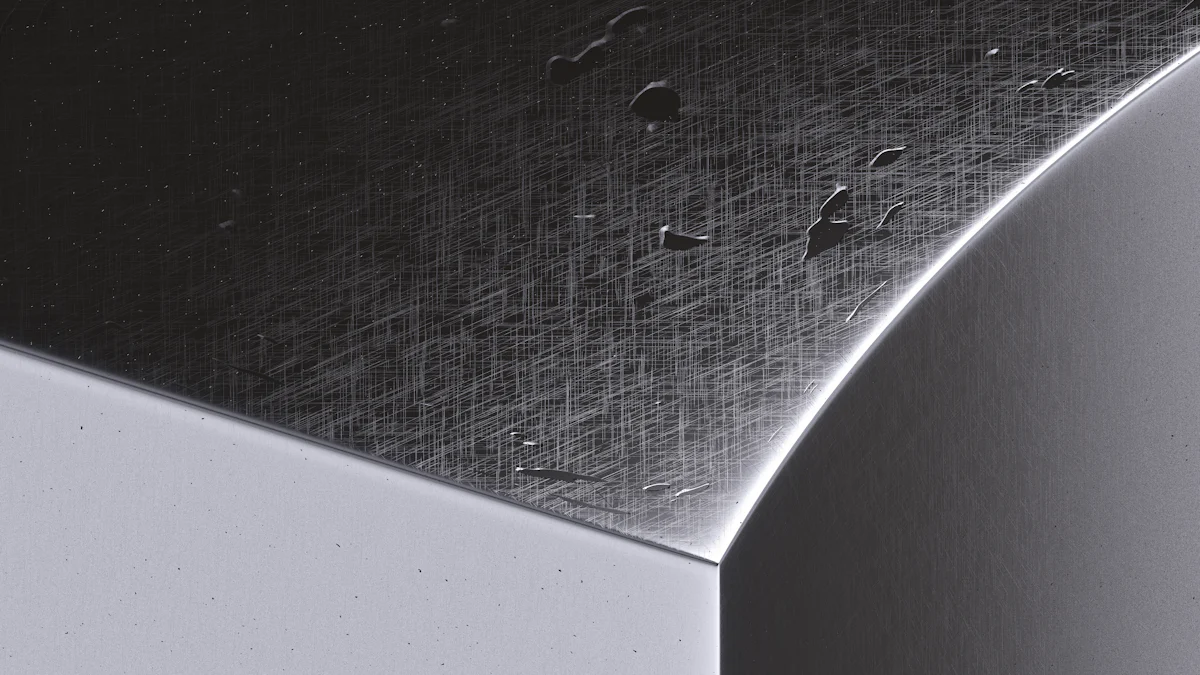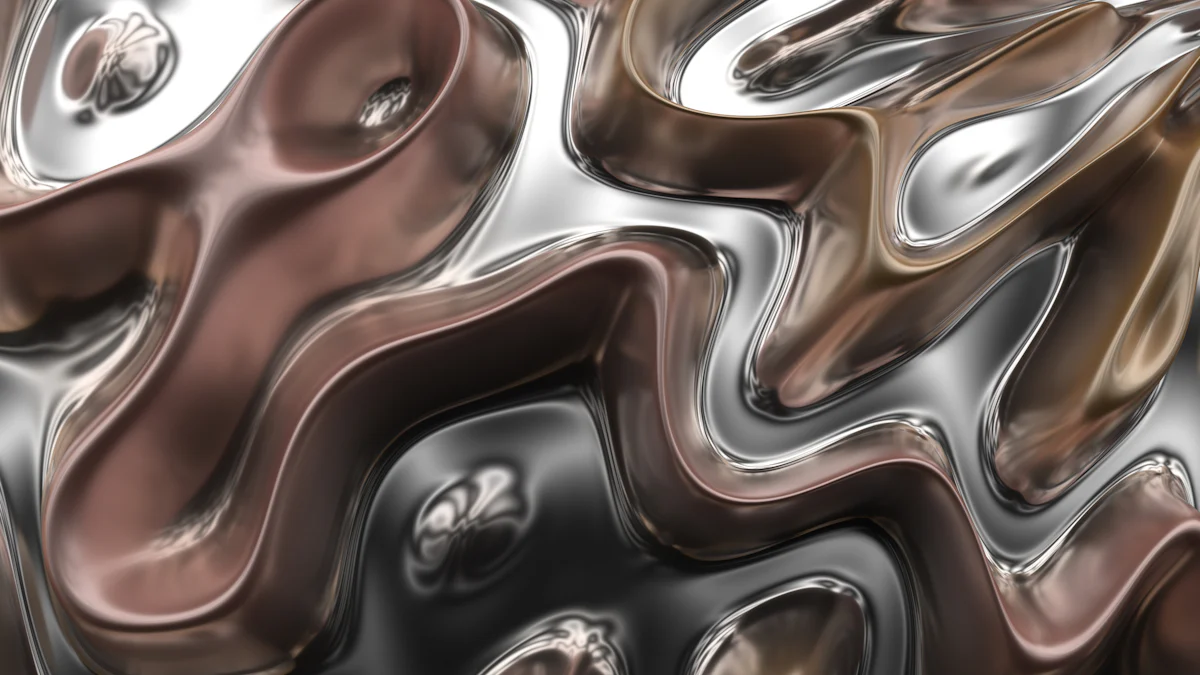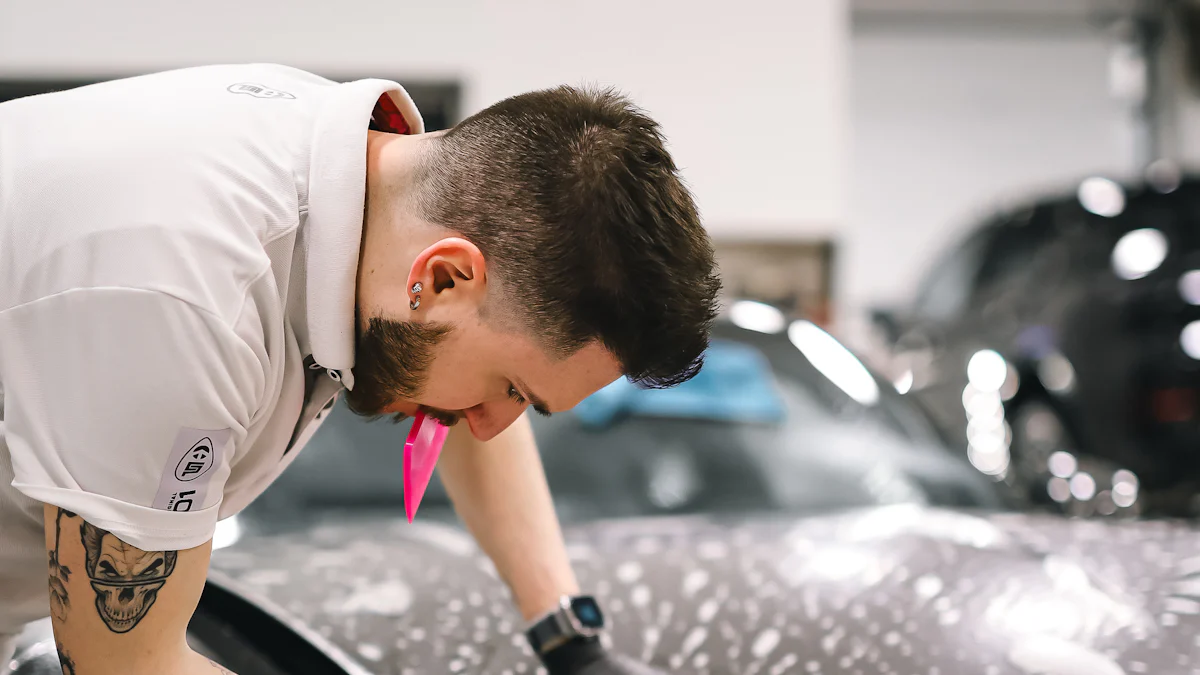10 Essential Surface Finishing Processes for Metals You Should Know

Metal surface finishing plays a vital role in improving the durability, appearance, and functionality of materials. You can find these processes in industries like automotive, aerospace, and construction, where high performance and reliability are essential. For example, a polished metal surface not only looks appealing but also resists wear and corrosion.
Surface finishing processes fall into two main categories: mechanical and chemical. Mechanical methods, such as grinding and polishing, physically alter the surface through abrasion. Chemical techniques, like anodizing and electroplating, rely on chemical reactions to enhance properties. The table below highlights some common surface finishing types:
Type of Process | Description |
|---|---|
Mechanical Processes | Physical alteration of the material’s surface through abrasion or deformation. |
Grinding | Uses abrasive media to remove material, resulting in a smoother finish. |
Polishing | Applies fine abrasive particles for a smooth, reflective finish. |
Buffing | Involves rotating wheels to apply compounds for a high-gloss finish. |
Chemical Processes | Relies on chemical reactions to alter surface properties. |
Anodizing | Forms a protective oxide layer on metals, enhancing corrosion resistance. |
Electroplating | Deposits metal ions onto a substrate, improving wear resistance and aesthetics. |
Chemical Etching | Uses chemical solutions to remove material, creating patterns or textures. |
Chrome Plating | Deposits chromium onto a substrate, increasing corrosion resistance and surface hardness. |
Powder Coating | Applies dry powder that is cured under heat for a durable coating. |
By understanding these processes, you can select the right surface finish to meet your specific needs.
Benefits of Metal Surface Finishing
Metal surface finishing offers a wide range of advantages, making it an essential step in manufacturing and industrial processes. Let’s explore how these processes enhance durability, improve aesthetics, and increase corrosion resistance.
Enhancing Durability
Metal surface finishing significantly improves the lifespan of materials. Processes like shot peening create compressive stresses on the surface, which enhance fatigue resistance and structural integrity. Passivation forms a protective oxide layer, reducing the risk of wear and tear. Electroplating adds a thin metallic coating that increases both wear resistance and durability.
Process | Benefit Description |
|---|---|
Shot Peening | Enhances fatigue resistance and durability by creating compressive stresses. |
Passivation | Improves corrosion resistance by forming a protective oxide layer. |
Electroplating | Increases corrosion and wear resistance through a thin metallic coating. |
Anodizing | Forms an oxide layer that enhances corrosion resistance and can be dyed. |
These techniques ensure that metals withstand harsh environments and maintain their structural integrity over time. Whether you’re working with automotive parts or industrial machinery, durability is key to long-term performance.
Improving Aesthetics
Metal surface finishing doesn’t just make materials stronger; it also enhances their appearance. Polished finishes give metals a sleek, reflective look, while anodizing allows for vibrant, dyed surfaces. Industries like automotive and aerospace rely on these processes to create visually appealing components. For example:
Automotive: Surface finishing enhances panels and trims for a polished, professional look.
Electronics: Precise finishes improve both functionality and aesthetic appeal.
Construction: Finishes contribute to the visual quality of building materials.
Whether you’re designing a smartphone or a car, a well-finished surface can elevate the overall design and make a lasting impression.
Increasing Corrosion Resistance
Corrosion is one of the biggest threats to metal longevity. Surface finishing processes act as a barrier against moisture and chemicals, preventing rust and degradation. Techniques like galvanizing, anodizing, and passivation create protective layers that shield metals from corrosive agents. Galvanizing, for instance, is highly effective for mild steel, while anodizing works best for aluminum and light metals.
By applying a corrosion-resistant coating, you can extend the life of your materials and reduce maintenance costs. This is especially important in industries like construction and aerospace, where environmental exposure is constant.
The benefits of metal surface finishing go beyond aesthetics and durability. They ensure your materials perform reliably, even in challenging conditions.
Optimizing Functionality for Specific Applications
Metal surface finishing plays a crucial role in tailoring materials for specific applications. By modifying the surface, you can enhance functionality to meet the unique demands of industries like aerospace, medical, and automotive. Each application benefits from precise finishing techniques that improve performance and reliability.
In aerospace, surface finishing ensures components can withstand extreme conditions. Shot blasting prepares surfaces for coatings, improving adhesion and structural integrity. Smoother finishes reduce friction between moving parts, which is vital for aircraft engines and other mechanical systems. These enhancements contribute to safer and more efficient operations.
In the medical field, surface finishing ensures safety and hygiene. Smooth, non-porous surfaces make sterilization easier, reducing the risk of contamination. Mass finishing techniques polish medical devices, minimizing tissue irritation and promoting better integration with the human body. For example, surgical implants require a flawless finish to ensure compatibility and durability.
Automotive applications also benefit from metal surface finishing. Polished surfaces reduce wear and tear on moving parts, improving efficiency and extending the lifespan of components. Abrasive blasting and powder coating protect car parts from corrosion, ensuring they perform well in harsh environments.
These processes optimize functionality by addressing specific challenges in each industry. Whether you need durability, corrosion resistance, or smoother surfaces, the right finishing technique can make all the difference. The benefits of metal surface finishing go beyond aesthetics, offering solutions that enhance performance and reliability across various fields.
Top 10 Surface Finishing Processes

Grinding
Definition and Process
Grinding is a mechanical surface finishing process that uses abrasive wheels to remove material from a metal surface. This process achieves a smooth and precise finish by rubbing the abrasive particles against the workpiece. Grinding is ideal for achieving tight tolerances and fine surface finishes. Unlike other machining methods, grinding excels in handling hard and brittle materials.
Aspect | Machining | Grinding |
|---|---|---|
Material Removal Rate | High, for bulk removal | Low, for surface finishing |
Dimensional Accuracy | Tolerance below 2µm is difficult | Tolerance as low as 0.5µm is feasible |
Cutting Tool | Defined geometry cutting tools | Grinding wheels with random abrasives |
Energy Consumption | Lower | Higher due to rubbing and scratching |
Thermal Effects | Less heat into the material | Significant heat can damage material |
Material Compatibility | Hard and brittle materials are tough | Handles hard, ductile, and tough materials |
Benefits
Grinding provides exceptional dimensional accuracy and surface smoothness. It works well for materials like hardened steel and ceramics. The process also minimizes defects, ensuring a high-quality finish.
Common Applications
You’ll find grinding used in industries like aerospace, automotive, and tool manufacturing. It’s essential for creating precision components like gears, bearings, and cutting tools.
Polishing
Definition and Process
Polishing is a metal surface finishing process that enhances the smoothness and shine of a material. It uses fine abrasive particles to remove minor imperfections, resulting in a reflective and aesthetically pleasing surface. Polishing is often the final step in surface finishing types to achieve a flawless appearance.
Benefits
Polishing improves both the appearance and functionality of metals. It reduces surface roughness, which minimizes friction and wear. Polished surfaces are also easier to clean and maintain.
Common Applications
Polishing is widely used for materials like stainless steel, aluminum, brass, and titanium. For example:
Stainless steel: Ideal for kitchen appliances and medical instruments.
Aluminum: Common in automotive and aerospace components.
Brass and copper: Popular for decorative items and sculptures.
Abrasive Blasting
Definition and Process
Abrasive blasting, also known as sandblasting, involves propelling abrasive materials at high speeds to clean or texture a metal surface. This process removes rust, paint, and contaminants, preparing the surface for further treatments like plating or electroless plating.
Benefits
Abrasive blasting ensures a clean and uniform surface. It enhances adhesion for coatings and improves the overall durability of the material.
Common Applications
This process is essential in industries like construction, automotive, and shipbuilding. It’s used to prepare surfaces for painting, coating, or plating. However, abrasive blasting can impact the environment. Dust and waste generation are common concerns. You can mitigate these by using eco-friendly abrasives, recycling waste, and employing dust control measures.
Matt Finishing
Definition and Process
Matt finishing is a surface finishing process that creates a non-reflective, smooth texture on metal surfaces. Unlike polishing, which enhances shine, matt finishing reduces gloss to achieve a subdued appearance. This process typically involves abrasive blasting, chemical etching, or sanding to remove surface irregularities and create a uniform texture.
Benefits
Matt finishing offers several advantages:
It reduces glare, making it ideal for applications where light reflection is undesirable.
The process hides minor imperfections, scratches, or blemishes on the surface.
It enhances the grip of the material, which is useful for tools and equipment.
Matt finishes provide a modern, sophisticated aesthetic that appeals to many industries.
Common Applications
You’ll find matt finishing used in industries like automotive, electronics, and architecture. It’s popular for creating sleek designs in consumer electronics, such as smartphones and laptops. In construction, it’s used for decorative metal panels and fixtures. Automotive manufacturers often apply matt finishes to achieve a premium look for car interiors and exteriors.
Electropolishing
Definition and Process
Electropolishing is a chemical surface finishing process that removes a thin layer of metal from the surface. This process uses an electrolytic solution and an electric current to dissolve surface material, leaving behind a smooth, polished finish. Electropolishing eliminates microscopic crevices and imperfections, making it one of the most precise metal surface finishing types.
Benefits
Electropolishing provides numerous benefits:
It creates smooth surfaces that enhance functionality and longevity.
The process increases corrosion resistance, outperforming many other methods.
It improves the physical appearance of metals, leaving a reflective, polished finish.
Electropolishing eliminates microscopic crevices, reducing the risk of contamination.
It reduces surface drag, improving performance in applications like fluid systems.
The process works on various part sizes and shapes, offering flexibility.
Common Applications
Electropolishing is widely used across industries:
Aerospace
Semiconductor
Electronics
Automotive
Appliances
Scientific research
Food and beverage
Medical and dental equipment
Pharmaceutical
Lasers
Agriculture
This process is essential for applications requiring high precision, cleanliness, and durability, such as surgical instruments, food processing equipment, and aerospace components.
Anodizing
Definition and Process
Anodizing is an electrochemical process that thickens the natural oxide layer on metal surfaces. This process primarily treats aluminum and titanium, enhancing their durability and appearance. During anodizing, the metal acts as an anode in an electrolytic cell, where an electric current passes through an acid solution. This creates a protective oxide layer that can also be dyed for aesthetic purposes.
Benefits
Anodizing offers several key advantages:
It increases hardness and corrosion resistance, making metals more durable.
The process adds negligible weight, preserving the material’s original properties.
Anodized surfaces can be dyed in various colors, enhancing their visual appeal.
The oxide layer improves wear resistance, extending the lifespan of components.
Common Applications
Anodizing is commonly used in industries like aerospace, automotive, and consumer goods. It’s ideal for aluminum parts in aircraft, where durability and lightweight properties are critical. Automotive manufacturers use anodizing for decorative trims and corrosion-resistant components. In consumer goods, anodized finishes are popular for cookware, electronics, and sporting equipment.
Aspect | Anodizing | Electroplating |
|---|---|---|
Process | Thickens the natural oxide layer on metals | Coats a metal surface with another metal |
Main Materials | Primarily aluminum and titanium | Various metals like gold, chrome, nickel |
Weight Change | Adds a negligible 1% or less | Can add up to 10% weight |
Strength Impact | Increases hardness and rust resistance | Can increase tensile strength by up to 20% |
Anodizing differs from plating processes like electroplating or electroless plating. While anodizing enhances the natural properties of the base metal, plating deposits a layer of another metal onto the surface.
Electroplating
Definition and Process
Electroplating is a chemical surface finishing process that deposits a thin layer of metal onto a substrate. This process uses an electric current to transfer metal ions from a solution onto the surface of the workpiece. You can use electroplating to enhance the appearance, durability, and corrosion resistance of metals. Unlike electroless plating, which relies on chemical reactions alone, electroplating requires an external power source to drive the deposition process.
Benefits
Electroplating offers several advantages:
It improves the wear resistance of metals, extending their lifespan.
The process enhances the aesthetic appeal by adding a shiny, uniform finish.
It provides a protective barrier against corrosion, especially in harsh environments.
Electroplating can also improve electrical conductivity for specific applications.
Common Applications
You’ll find electroplating used in industries like automotive, electronics, and jewelry. It’s ideal for chrome-plated car parts, gold-plated connectors, and decorative finishes on watches and accessories. This process ensures both functionality and visual appeal.
Powder Coating
Definition and Process
Powder coating is a dry finishing process that applies a powdered material to a metal surface. The powder adheres to the surface using an electrostatic charge and is then cured under heat to form a durable, even coating. This method creates a thick, hard layer that resists cracking, peeling, and wear. Unlike traditional wet paint, powder coating contains no volatile organic compounds, making it an environmentally friendly option.
Benefits
Powder coating provides unmatched durability and versatility:
It creates a tough, long-lasting finish that withstands impacts and abrasions.
The thick coating resists cracking and peeling, even on moving parts.
It adapts well to items that experience shape changes or frequent handling.
Powder coating offers excellent protection against debris, making it ideal for transportation equipment.
The absence of harmful chemicals ensures a safer application process.
Common Applications
You’ll see powder coating used in industries like automotive, construction, and consumer goods. It’s perfect for coating car rims, outdoor furniture, and household appliances. This process ensures a high-quality finish that lasts for years.
Passivation
Definition and Process
Passivation is a chemical process that enhances the corrosion resistance of stainless steel. During this process, the metal surface reacts with oxygen to form a thin, self-healing chromium oxide layer. This protective film prevents rust and degradation, even in harsh environments. Passivation typically involves cleaning the metal with an acid solution to remove contaminants before the oxide layer forms.
Benefits
Passivation offers several key benefits:
It significantly improves the corrosion resistance of stainless steel.
The process enhances the longevity of metal components by preventing rust.
Passivated surfaces are smoother and easier to clean, reducing maintenance needs.
Common Applications
Passivation is widely used in industries like medical, aerospace, and food processing. It’s essential for surgical instruments, aircraft components, and food-grade equipment. This process ensures safety, hygiene, and durability in critical applications.
Hot-Dip Galvanizing
Definition and Process
Hot-dip galvanizing is a surface finishing process that coats metal with a layer of zinc to protect it from corrosion. You achieve this by immersing the metal in molten zinc, which bonds to the surface through a metallurgical reaction. This creates a durable, protective layer that shields the base metal from environmental damage. The process involves three main steps: surface preparation, galvanizing, and inspection.
Surface Preparation: Clean the metal by removing dirt, grease, and rust through degreasing, pickling, and fluxing.
Galvanizing: Immerse the cleaned metal into a bath of molten zinc heated to around 840°F (449°C).
Inspection: Examine the coated metal to ensure uniform coverage and proper adhesion.
This method ensures complete coverage, even in hard-to-reach areas like corners and edges.
Benefits
Hot-dip galvanizing offers numerous advantages, making it a popular choice for industrial applications:
Provides exceptional resistance to rust and corrosion.
Protects even small, hard-to-reach areas.
Prolongs the lifespan of metal, often exceeding 50 years in average environments.
Requires no maintenance, saving you time and effort.
Offers sacrificial protection, where the zinc coating corrodes instead of the base metal.
Reduces costs compared to treated steels or frequent replacements.
Ensures immediate usability upon delivery, eliminating delays.
Withstands mechanical wear and tear, making it reliable for heavy-duty use.
These benefits make hot-dip galvanizing both cost-effective and durable for large-scale projects.
Common Applications
You’ll find hot-dip galvanizing used in industries like construction, transportation, and agriculture. It’s ideal for structural steel, bridges, and highway guardrails due to its long-lasting protection. In agriculture, galvanized steel is common for fencing, silos, and irrigation systems. The process also protects utility poles, pipelines, and outdoor furniture from harsh weather conditions.
Hot-dip galvanizing ensures your metal components remain strong and corrosion-free, even in demanding environments.
How to Choose the Best Sheet Metal Finish

Selecting the best sheet metal finish requires careful consideration of several factors. Each decision impacts the durability, appearance, and functionality of your final product. By evaluating the material type, desired outcome, and application environment, you can choose the right process for your needs.
Consider the Material Type
The type of metal you’re working with plays a significant role in determining the appropriate surface finish. Different metals respond differently to various treatments. For example:
Anodizing works best for aluminum and other non-ferrous metals.
Passivation is ideal for stainless steel, enhancing its corrosion resistance.
Hot-dip galvanizing provides excellent protection for steel in outdoor environments.
Not all finishes are compatible with every metal. Understanding the properties of your material ensures you select a process that enhances its strengths while addressing its weaknesses. This step is crucial for achieving a durable and effective finish.
Evaluate the Desired Outcome
Your goals for the finished product will guide your choice of sheet metal finishing. Consider the following factors:
Aesthetic requirements: Do you need a glossy, matte, or textured surface?
Functional needs: Will the part require wear resistance, electrical conductivity, or corrosion protection?
Industry standards: Some industries, like medical or food processing, have strict regulations for surface finishes.
Brand consistency: Products may need to align with specific visual or quality standards for branding purposes.
By defining your priorities, you can narrow down the options and select a finish that meets both functional and visual expectations.
Assess the Application Environment
The environment where your product will be used also influences the choice of surface finish. Outdoor applications, for instance, demand finishes that withstand harsh conditions. Consider these environmental factors:
Environmental Factor | Description |
|---|---|
Environmental Durability | Excellent weather resistance suitable for outdoor applications. |
Corrosion Protection | Zinc provides excellent protection to underlying steel in harsh environments. |
Environmental Impact | Minimal impact from dry coating processes; alternatives to hazardous chemicals available. |
If your product will face moisture, chemicals, or extreme temperatures, prioritize finishes like hot-dip galvanizing or powder coating. These processes provide long-lasting protection and ensure your product performs reliably in challenging conditions.
By considering these factors, you can confidently choose the best sheet metal finish for your project. This approach ensures your materials meet their intended purpose while maintaining quality and durability.
Factor in Cost and Efficiency
When selecting a surface finishing process, you must consider both cost and efficiency. These factors directly impact your project’s budget and timeline. By evaluating them carefully, you can choose the right process that balances quality and affordability.
Cost Considerations
Surface finishing processes vary widely in cost. Some methods, like grinding or polishing, are relatively inexpensive. Others, such as anodizing or hot-dip galvanizing, require specialized equipment and materials, increasing their price. To manage costs effectively:
Assess your budget: Determine how much you can allocate to sheet metal finishing.
Compare options: Research the costs of different processes and identify those that fit your budget.
Account for long-term savings: Some finishes, like powder coating, may cost more upfront but reduce maintenance expenses over time.
Efficiency Factors
Efficiency plays a crucial role in meeting deadlines and maintaining productivity. Processes like abrasive blasting or passivation are quick and suitable for large-scale projects. Others, like electropolishing, may take longer but deliver precise results. To optimize efficiency:
Evaluate project size: For high-volume tasks, prioritize methods that handle large quantities efficiently.
Consider application time: Choose processes that align with your production schedule.
Factor in durability: A durable finish reduces the need for rework or replacements, saving time in the long run.
Tip: Balancing cost and efficiency ensures you achieve the best sheet metal finish without compromising quality or exceeding your budget.
By analyzing these aspects, you can make informed decisions about sheet metal finishes. This approach helps you choose the right process for your specific needs while keeping costs and timelines under control.
Surface finishing processes play a vital role in enhancing the durability, functionality, and appearance of metals. They protect materials from corrosion, improve chemical resistance, and eliminate surface defects. The 10 essential surface finishing types, such as grinding, anodizing, and powder coating, offer unique benefits like increased strength, wear resistance, and aesthetic appeal. By understanding these processes, you can choose the right process to meet your specific needs.
When selecting the best sheet metal finish, consider the material type, application environment, and desired outcome. Consulting experts ensures you achieve optimal results. Whether you need durable sheet metal finishes or a polished aesthetic, the right choice can transform your project.
FAQ
What is the main purpose of metal surface finishing?
Metal surface finishing improves durability, appearance, and functionality. It protects metals from corrosion, wear, and environmental damage. Additionally, it enhances aesthetics by creating smooth, polished, or textured surfaces. You can also use it to prepare metals for specific applications, such as medical devices or aerospace components.
How do I choose the right surface finishing process?
You should consider the type of metal, the desired outcome, and the environment where the product will be used. For example, anodizing works well for aluminum, while hot-dip galvanizing protects steel in outdoor conditions. Always match the finish to your project’s needs.
Are surface finishing processes environmentally friendly?
Some processes, like powder coating, are eco-friendly because they avoid harmful chemicals and reduce waste. Others, like abrasive blasting, may generate dust or waste. You can minimize environmental impact by choosing sustainable methods and recycling materials whenever possible.
Can surface finishing improve corrosion resistance?
Yes, many processes enhance corrosion resistance. Techniques like anodizing, passivation, and hot-dip galvanizing create protective layers that shield metals from moisture and chemicals. These finishes extend the lifespan of materials, especially in harsh environments.
Is surface finishing necessary for all metal products?
Not all metal products require surface finishing. However, if you need durability, corrosion resistance, or a specific appearance, finishing is essential. Industries like automotive, aerospace, and medical rely on these processes to meet performance and safety standards.
See Also
Understanding Various Powder Coating Techniques and Applications
Importance of Metal Substrates in Today's Industrial Landscape
An Overview of Sandblasting Techniques and Their Uses
Finding Optimal Die Casting Closing Force for Your Product
Understanding Functional Testing in CNC and Die Casting
About Hunan Puka
Established in 2016 and based in Hunan, China, with a liaison point in Berlin, we are a Tier 2 supplier for the automobile industry. We specialize in the production of customized aluminum die-casting parts designed for machines with a closing force ranging from 280 to 800 tons, with subsequent manufacturing process CNC machining and surface treatment. Our commitment to quality is reflected in our accredited quality management system, certified by ISO9001:2015 and IATF16949:2016 standards.


